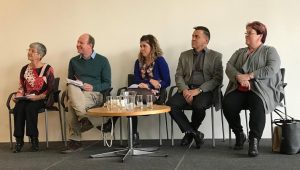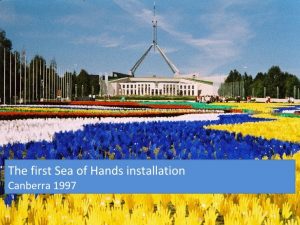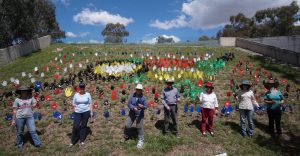David Hunter Memorial Lecture 2017
Looking Forward, Looking Back –
steps towards justice, rights, respect
Note: This summary is taken from notes the author made on the night.
In addition to the speakers, there were also three stalls, from Amnesty International’s Indigenous Rights Group, Oxfam and Burrunju Aboriginal Art Gallery.
Aunty Agnes began the 2017 lecture with a warm Welcome to Ngunnawal Country, acknowledging her friendship with David Hunter, and his work on Indigenous rights.
Stephen Pickard (director of ACCC) noted their pleasure in hosting the DHML again, and particularly this time having a Sea of Hands on the hill beside the centre.


Looking back – the first Sea of Hands
Janet Hunt, a long-time member of ANTaR, MC’d and began by reflecting on the history of the Sea of Hands.
The first display, of 70,000 hands, was on 12 Oct 1997 and launched by Charlie Perkins. It had come about because a group of activists with an interest in ensuring that there was strong native title legislation wanted to present a petition to Parliament, but a lot of petitions go to Parliament and they wanted this one to be different and to be noticed. Jo Holder, Sydney activist, came up with the idea for a Sea of Hands, with each hand representing a person supporting strong action on native title.
The first Sea of Hands had been at a time when parliament was not sitting, so there was a second display, this time of 120,000 hands, in November. The full Sea of Hands was subsequently displayed in multiple locations around Australia.
Tristian Ray shared his memories of helping put together the first Sea of hands, when he was aged 20 and working for 2XX. Tristan now works for CAYLUS (Central Australia Youth Link-Up Service), promoting the use of Opal fuel in communities. He has used a lot of his Sea of Hands experience in this role.
ANTaR was already a strong group by then. The Sea of Hands bought together a group of non-Indigenous people who took responsibility for what had happened, and provided a powerful forum for Indigenous people to speak. With leadership, people were ready to acknowledge the past and to do good things.
Tristan remembered the team having to beg and borrow things to make it happen. The truck carrying the hands broke down on the way and the hands were stuck out of town – had people with cars to bring the hands in. For planting the hands, the designers said that they couldn’t mark the ground so drawing the pattern was a nightmare.
David Cooper was also part of the team. He acknowledged David Hunter, who was a very valued member of core group of activism, along with Charlie Pahlman and Kristie Guest, who have also passed away since. Being part of the Sea of Hands was a foundational experience – amazing what a small group can do. The first Sea of Hands was a challenge, and they were not sure how they could do a second, much bigger, installation a few months later. For the second, they had 500 people turn up on a week day in drizzle and the hands were planted by 9.30am. The Sea of Hands enabled ANTaR to build more of a national organisation – people saw the value of the group and what was needed to progress Indigenous rights in this country.

Looking back – the past 20 years
Before introducing Shannan Dodson, Janet acknowledged the presence of her father, Prof Mick Dodson, in the audience. He is one of the Indigenous leaders who inspired us all, and has done substantial work over many years on native title rights.
Shannan recalled key events that have happened in her lifetime, beginning when she was two with the Barunga Statement presented to Prime Minister Bob Hawke, who promised a treaty in the life of his parliament. Since then:
- When she was three, ATSIC (Aboriginal and Torres Strait Islander Commission) was formed.
- When she was in level 1, the High Court handed down the Mabo decision.
- When she was eight years old, the Native Title Act came law, and the Land Fund established. This had a big impact on her family and her mob, with a Native Title claim for the Yawuru people.
- At age 11, ANTaR began and the Bringing Them Home report was presented, bringing attention to the experience of the stolen generation.
- At age 12, she remembers dancing at Bondi Beach at a Sea of Hands installation.
- In her teens, the Council for Aboriginal Reconciliation presented the Corroboree 2000 documents and she joined others walking over the Sydney Harbour Bridge. At the Sydney Opera House, people called ‘shame’ and turned their backs on John Howard.
- Because of the work of others, she was able to finish high school. At her first year at university, ATSIC was abolished, the Government saying Aboriginal people couldn’t manage own affairs.
- The Yawuru community native title claim was recognised, then it took another four years until agreements officially recognised in 2010.
- In 2012, the Expert Panel reported to Gillard government recommending changes to the Constitution. She then spent next five years campaigning for these changes, through four prime ministers, many cuts and numerous bad policy decisions. Shannan saw frustration and anger continue to grow in her people.
- Then the Uluru Statement from the Heart came. It was not a surprise but the government rejection was deeply reprehensible.
Shannan talked about the ways her family has continued to fight in face of setbacks before. Her mob didn’t stop fighting to be recognised as the holders of the land. Her grandad and grandma had to fight to be together. She will fight on for future generations and so her nephew grows up knowing that he is equal to those around him.

(volunteers with puddle of hands beside the Australian Centre for Christianity and Culture, October 2017)
Looking Forward – Uluru Statement from the Heart
Chris Bourke and Jennie Gordon are on the Uluru Statement working group, representing Canberra and the wider region, including Jervis Bay.
Chris talked about the background to the statement, and the many discussions that led to the gathering at Uluru. Virgin Australia put on a special flight to take delegates over and it had, for the first time, an entirely Aboriginal and Torres Strait Islander crew. Three days of debate and discussions coalesced into Uluru Statement from the Heart, with three simple asks: representation, agreement-making and truth telling.
Chris said that there was nothing new here – they are all issues that have been repeatedly raised in past advocacy. There have been calls for representation since William Cooper and Doug Nicholls, calls for a treaty since Fred Maynard wrote a letter to the NSW Premier, the Yirrkala bark partition was presented, the Barunga statement made. This is not new, and should have come as no surprise to politicians that this is what Indigenous people want.
What they want from representative voice is a voice that says what needs to be said, a voice that is not selected but strong, from a structure embedded in the constitution, and that will not be chopped like ATSIC.
The representative voice can oversee race powers, which are completely unfettered at the moment – governments have done good things with the powers, but have also done terrible things. As to how this could work, can look at the ACT Indigenous Elected Body and the estimates hearings they hold, where public servants are held to account. There are some issues still to be worked through but having a voice would be a start and a step to self determination.
Jennie acknowledged that the members of the working group are not known leaders. They are the group from Uluru that have been given this mandate. Their role is to coordinate and facilitate strong and powerful leaders to move this forward so government will hear what they have to stay. Prior to the disappointments of the past week, the working group organised a meeting in Grampians to discuss how to move forward, and they will keep up the momentum.
The Statement is set out with great thought and ambition. Uluru is a powerful place with important sacred sites – you can’t walk away without being really taken into the spirit of the land. Jennie showed a photo of her boots covered in red dust, noting that their boots were going to get dirty.
Jennie talked about her personal connection to the work. She had family members who died from not being able to access health services – this was powerful in her decision of a career in the health sector. Truth telling is very significant and important to move forward understanding what has happened in this land.
To finish, she talked about some signs of hope, with the gap between outcomes changing. As Stan Grant noted, today there are more Aboriginal and Torres Strait Islander people with university degrees than in jail and that is a very positive situation. http://www.abc.net.au/news/2017-02-14/closing-the-gap-a-little-window-of-hope-stan-grant/8266332
Questions
Questions on whether the Uluru Statement was asking too much and how to build support for the Statement.
Chris said the Uluru Statement was not asking too much. The easy way would have been for the conservative part of the Liberal party to support the statement. But this will not be not the easy way – will work on strategies at the three day workshop in the Grampians.
Chris and Jennie talked about their role on the working group being on a voluntary basis, without funding. The National Congress of Australia’s First Peoples are coming to the Grampians. They need support from other organisations and are seeking strategic partnerships.
Shannan talked about the importance of ANTaR in continuing the push, getting people together for coordinated effort, and to focus people’s attention.
1 thought on “Looking Forward, Looking Back: 31 October 2017”